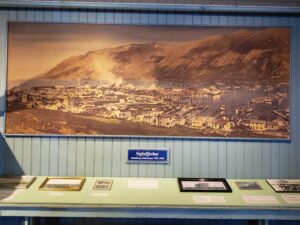Today we travelled from Myvatn to Siglufjordur, a small town on the northern coast of Iceland. One of the main reasons we travelled to Siglufjordur is because of the major boom and bust nature of the town with the fishing and selling of herring. Siglufjordur was not even a town before 1900, just scattered families in a common area. Once the Norwegians discovered that herring migrate to this fjord during the 2-3 months during the summer, it caused a huge transformation. This place turned from a few families into the 5th largest population in Iceland. The town grew exponentially overnight causing massive growth of houses, infrastructure, and money. The herring were ultimately overfished and were not able to be made profitable, causing a large economic bust here and for much of the population to move away. Between 1903 and 1968 Siglufjordur changed from nothing to contributing 40% of all exports for the country of Iceland, and then back to somewhat of a ghost town for a while.

We visited the Herring Era Museum here in Siglufjordur which tells the history of the herring industry and the town. The layout of the museum was intended to preserve the natural layout of the industry. It consisted of three buildings- a salting station, a factory, and a boathouse. This museum like many of the other ones we have visited was created in the building/space of the original buildings. While walking through the museum I got the distinct feeling that this museum, somewhat unlike the rest, was specifically for the people of Siglufjordur. It was built to tell their history to them, and conveniently became a tourist attraction to the town as well later on.

The boom and bust event here is not just limited to Iceland and not only limited to this time, it is found everywhere and is very cyclical. Booms and busts tend to happen when a town, city, or country invests much(if not all) of its time and money into only one thing. In Siglufjordur the booming economy created a town where one did not exist before and after it crashed, half the town left and they had no significant sources of income for the town. For Siglufjordur it was herring, but we see this in American history and still today with cities in America. In the past there were many economic surges and collapses, such as the gold rush which helped with discovering and mapping the western side of the country. Some other past examples include the railroad industry, many oil hotspots, and an argument can even be made for slavery being a boom and bust which had tremendous impacts on the racial demographic and tensions in America today. There are long term and short term predicted busts of booming economic businesses. An example of the long term predicted bust would be tourism once we inevitably use up all the oil, effectively halting the easiness of transportation. An example of a bust currently would be the car industry of Detroit. These booms and busts cause significant social and economic ramifications both while the economy is successful, and after it crashes.

In the book Independent People, the main character Bjartur owns his own farm. When that farm financially crashes due to not being able to sell his sheep he leaves to town to find other work. He ends up working for a merchant and is making profits for a while but this economic business crashes as well and he is left without income and needs to return to his farm. This example of an economic boom and bust is a perfect, although fictional, telling of the repetition of these processes. This show the cyclical nature of these booms and busts and ultimately the cyclical nature of us as human beings, repeating our past mistakes over and over again.

Anna St. Dennis-Happy birthday from Isabel!!
Leave a Reply